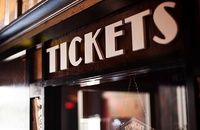GROUPON GUIDE TO HOUSTON
What’s the Future of Drive-In Theaters in the Age of Streaming?
BY: Andy Seifert |May 13, 2019
Movie Deals Near You

Trending
AMC: Yellow Tickets & Snacks – Experience big-screen magic Anytime!
510 Texas Street, Houston • 5.4 mi
25% discount_off
$5.03 with_code SHOWTIME
AMC Theatres

Trending
AMC First Colony 24
3301 Town Center Boulevard South, Sugar Land • 15.5 mi
book_now
AMC First Colony 24

Trending
Regal Premiere Movie Tickets for One, Two or Four for Movie Magic!
3839 Weslayan Street, Houston • 1.9 mi
12% discount_off
Regal

Up to 15% Off Movie Club Membership at Cinemark
310 Memorial City Mall, Houston • 5.3 mi
9% discount_off
$24 with_code GROUPON
Cinemark

Drive-in Movie Adventure with Scenic Views and Refreshments
100 Bringhurst Street, Houston • 7.4 mi
31% discount_off
$32.76 with_code GROUPON
Moonstruck Drive In

AMC Willowbrook 24
17145 Tomball Parkway, Houston • 14.5 mi
book_now
AMC Willowbrook 24

AMC Deerbrook 24
20131 U.S. 59, Humble • 20.8 mi
book_now
AMC Deerbrook 24

AMC Katy Mills 20
5000 Katy Mills Circle, Katy • 21.3 mi
book_now
AMC Katy Mills 20

AMC Gulf Pointe 30
11801 South Sam Houston Parkway East, Houston • 18.0 mi
book_now
AMC Gulf Pointe 30

AMC Spring 10
20115 Holzwarth Road, Spring • 20.9 mi
book_now
AMC Spring 10

AMC Fountains 18
11225 Fountain Lake Drive, Stafford • 11.0 mi
book_now
AMC Fountains 18

AMC Metropark Square 10
8870 Metropark Drive, Shenandoah • 30.3 mi
book_now
AMC Metropark Square 10

6% Off 3-Month Subscription to Regal Unlimited Movie Pass
6% discount_off
$64.50 with_code UNLIMITED
Regal Cinemas

AMC Houston 8
510 Texas Street, Houston • 5.4 mi
book_now
AMC Houston 8

AMC CLASSIC Brazos Mall 14
100 Texas 332, Lake Jackson • 48.8 mi
book_now
AMC CLASSIC Brazos Mall 14




